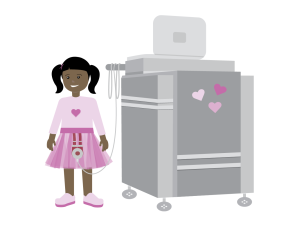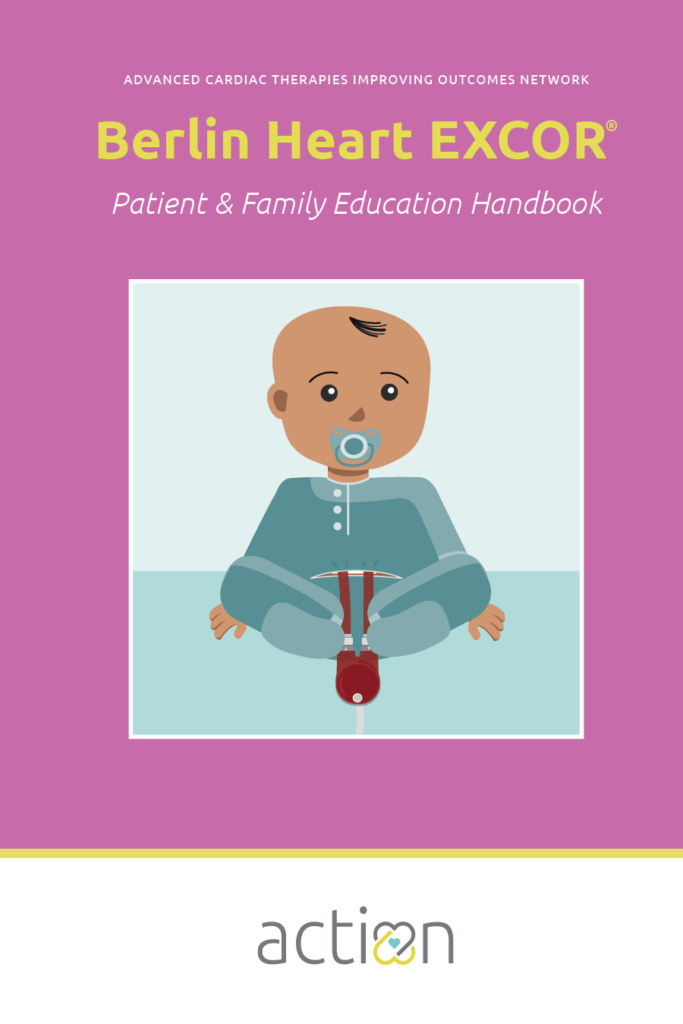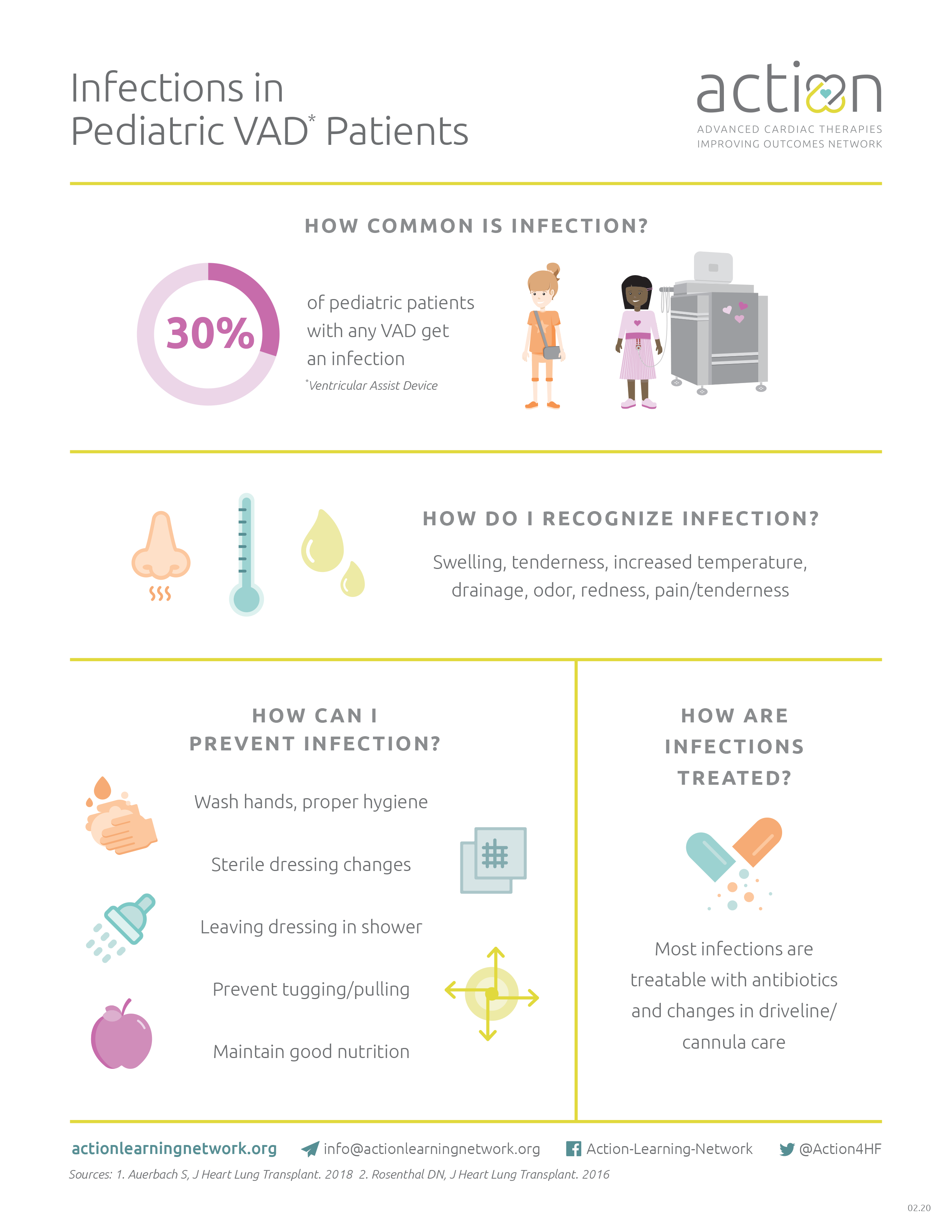
The Berlin Heart EXCOR® (or Berlin Heart) is one of the first-ever VADs designed for infants and children. It has been implanted in thousands of children around the world and can help you get stronger, so you can be in the best place possible to receive a heart transplant. Sometimes, the Berlin Heart will allow your heart to recover so that you may no longer need the VAD and can have it removed. Your care team will talk to you about all of your options. Because the Berlin Heart has been around for a long time, there are plenty of experts around the world that can help support you. Rest assured that you are in very safe hands.
Already have a Berlin Heart EXCOR®?
Want more information? Check out our Berlin Heart EXCOR® ACTION Patent Education Handbook in English or in Spanish.
-
Device Components
-
Benefits
-
Risks
Device Components
Cannulae
During VAD surgery, your heart surgeon will place cannulae that are special tubes made of a very soft silicone material. These soft cannulae will come out of your lower chest area just below your breastbone.
Your heart has two pumping chambers, a left ventricle and a right ventricle. Your cardiologist and surgeon will decide if you need support on just one ventricle or both. If you only need support for one ventricle, you will have two cannulae. If you need support for both ventricles, you will need four cannulae.
Blood Pump
The soft cannulae connect to a blood pump that is chosen especially for you. This blood pump is hand-crafted by scientists and engineers to provide adequate blood flow to your entire body. It’s like a little heart that is outside of your body.
Your blood pump has another tube connected to it where air will move in and out of it. But don’t worry, the air will not go into your body. Instead the air helps the blood pump to fill and push blood out just like a real heart can.
IKUS
The IKUS is an air compressor that helps move air in and out of your blood pump, helping it fill and eject. Your Berlin Heart makes a humming sound, which is normal. A computer sits on top of the IKUS and allows doctors to adjust the settings of your Berlin Heart. There are several settings your care team may adjust, like the air pressure strength, how often the air pressure moves in and out, and how many times your Berlin Heart pumps.
Benefits

The Berlin Heart helps patients with heart failure, as it improves blood circulation. A Berlin Heart may help reduce heart failure symptoms and improve quality of life while waiting for a heart transplant or your heart to get better.
Risks
 There are some risks with a Berlin Heart, but your care team will work hard to keep you safe.
There are some risks with a Berlin Heart, but your care team will work hard to keep you safe.
Infection
The soft cannula will come out of your lower chest and will need to be cleaned frequently. This is important because bacteria lives on your skin and may cause an infection at your cannula site. You may feel nervous the first few times your dressings are changed, but your care team will be there to support you.
Stroke
There is a risk of stroke with all VADs. A clot can form in the VAD, become dislodged, and may travel up a blood vessel to the brain. A blood clot in the brain leads to a decreased blood flow to the brain in that specific area, and this is called a stroke. Your care team will manage your blood thinner medicines and levels carefully to try to prevent a stroke. Sometimes, even with perfect levels, a stroke will occur.
Your care team will monitor you for the following symptoms:
- Headache
- Confusion
- Numbness and/or tingling on one side of the body
- Weakness on one side of the body
- Slurred speech
Bleeding
There is a risk of bleeding with all VADs. To prevent clots from forming in the device, you have to be on a blood thinner. Sometimes the blood thinner will lead to bleeding that may require a change in medicines, a blood transfusion, or in some cases, a surgery to stop the bleeding. Your care team will manage your blood thinner medicine and levels carefully to try to prevent bleeding. Sometimes, even with perfect levels bleeding will occur.
Pediatric VAD Infections
Download the pdf to learn more.
Take ACTION Reducing Stroke Rates
Download the pdf to learn more.
Device Components
Cannulae
During VAD surgery, your heart surgeon will place cannulae that are special tubes made of a very soft silicone material. These soft cannulae will come out of your lower chest area just below your breastbone.
Your heart has two pumping chambers, a left ventricle and a right ventricle. Your cardiologist and surgeon will decide if you need support on just one ventricle or both. If you only need support for one ventricle, you will have two cannulae. If you need support for both ventricles, you will need four cannulae.
Blood Pump
The soft cannulae connect to a blood pump that is chosen especially for you. This blood pump is hand-crafted by scientists and engineers to provide adequate blood flow to your entire body. It’s like a little heart that is outside of your body.
Your blood pump has another tube connected to it where air will move in and out of it. But don’t worry, the air will not go into your body. Instead the air helps the blood pump to fill and push blood out just like a real heart can.
IKUS
The IKUS is an air compressor that helps move air in and out of your blood pump, helping it fill and eject. Your Berlin Heart makes a humming sound, which is normal. A computer sits on top of the IKUS and allows doctors to adjust the settings of your Berlin Heart. There are several settings your care team may adjust, like the air pressure strength, how often the air pressure moves in and out, and how many times your Berlin Heart pumps.
Benefits

The Berlin Heart helps patients with heart failure, as it improves blood circulation. A Berlin Heart may help reduce heart failure symptoms and improve quality of life while waiting for a heart transplant or your heart to get better.
Risks
 There are some risks with a Berlin Heart, but your care team will work hard to keep you safe.
There are some risks with a Berlin Heart, but your care team will work hard to keep you safe.
Infection
The soft cannula will come out of your lower chest and will need to be cleaned frequently. This is important because bacteria lives on your skin and may cause an infection at your cannula site. You may feel nervous the first few times your dressings are changed, but your care team will be there to support you.
Stroke
There is a risk of stroke with all VADs. A clot can form in the VAD, become dislodged, and may travel up a blood vessel to the brain. A blood clot in the brain leads to a decreased blood flow to the brain in that specific area, and this is called a stroke. Your care team will manage your blood thinner medicines and levels carefully to try to prevent a stroke. Sometimes, even with perfect levels, a stroke will occur.
Your care team will monitor you for the following symptoms:
- Headache
- Confusion
- Numbness and/or tingling on one side of the body
- Weakness on one side of the body
- Slurred speech
Bleeding
There is a risk of bleeding with all VADs. To prevent clots from forming in the device, you have to be on a blood thinner. Sometimes the blood thinner will lead to bleeding that may require a change in medicines, a blood transfusion, or in some cases, a surgery to stop the bleeding. Your care team will manage your blood thinner medicine and levels carefully to try to prevent bleeding. Sometimes, even with perfect levels bleeding will occur.
Pediatric VAD Infections
Download the pdf to learn more.
Take ACTION Reducing Stroke Rates
Download the pdf to learn more.



